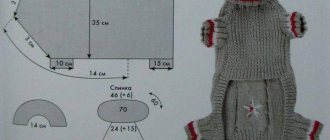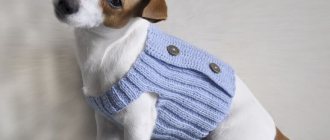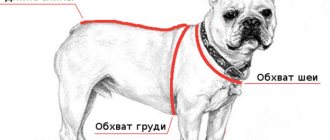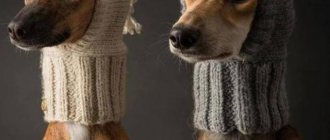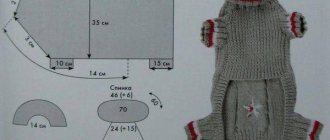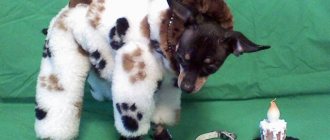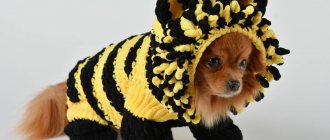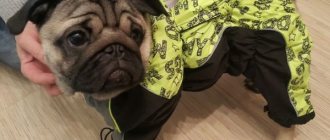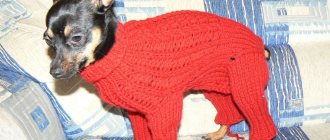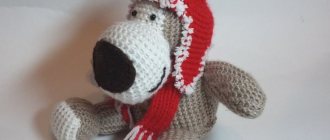Clothing for small dogs is not an attractive attribute, but a necessity. A dog of a hairless or toy breed will freeze in cool weather, and the desire to walk it longer will not help in achieving your goals. Today you can find many types of clothes for a small dog - overalls, blankets and others. All of them are expensive, and sellers do not always allow you to try on the intended purchase. I bring to your attention a knitted sweater for dogs that will please your pet and save the family budget.
Selection of yarn and knitting needles
Yarn and knitting needles are selected together. Depending on the model, you need to choose a knitting needle. If the raglan model is something you see very often, then you should definitely choose double needles. Regular knitting needles with eyes will serve as good friends for making classic patterns.
You need to carefully choose the yarn for your “favorite”; cheap and cold ones are not suitable.
A dog, like a child, requires warmth and affection. This is exactly what the yarn should be like. The yarn is selected for the cold season, and the more warm fibers it contains, the better.
Melange sweater
Dog weight: 12-15kg.
We will need:
- melange yarn, composed of 77% acrylic, 20% wool, 3% polyamide (50g per 70m) – 150g;
- knitting needles No5 and No6.
Patterns:
- cutting: 2l.x2i.;
- persons Ch.: alternate p. persons p. with a row of purl.
Density: face. Ch. 12p. for 19 rub. will be 10cm by 10cm.
Description
Back
Using knitting needles No. 5, cast on 50 stitches. and knit 8p. cutting Let's go to sp. No6 and persons. Ch.
At an altitude of 36 rubles. (19 cm) on both sides we decrease the loops, retreating 2 stitches. from the edge: 2l., 2p. in 1 sheet, faces. to the extreme 4 p., 1 simple broach, 2 l. In 2 rubles repeat the decrease.
On the remaining 46p. let's continue working. Having knitted 58r. (30cm), move on to cutting with knitting needles No. 5. We knit 16 rubles. (this is 8cm) and closed. P.
Tummy
Using knitting needles No. 5, cast on 26 stitches. and do 8 rubles. cutting Let's go to sp. No6 and persons. Ch. From 36r. (19cm) on both sides we decrease by 1 stitch, as described for the back. We repeat the decrease through the row. There are 22 stitches left, on which we knit evenly. From 58r. (30 cm) using knitting needles No. 5, we knit a sweater for a dog using cut knitting. We knit 16 r. (8 cm) and close. P.
Mittens
Sp. No5 dial 26p. and knit 12 rubles in the round. (6cm) cutting. We do not close the loops. We knit the second sleeve in the same way.
Assembly
We sew the upper sections of the cutting. We sew the sleeves with a loop stitch. We make the side seams.
Features of knitting a sweater for a dog on knitting needles
To create a sweater for a dog, you need to go through several steps:
Stage 1: taking measurements
When measuring, take into account that the “pet” will be active in the finished sweater and therefore immediately make adjustments of a few centimeters:
- product length (from collar to tail);
- width of the product (between the front and back paws);
- back and chest circumference;
- distance between paws;
- waist (abdomen) circumference;
- OL - paw circumference;
- ОШ - neck circumference.
How to take measurements from a dog
The peculiarity of a dog sweater is that the back is usually knitted wider and longer; especially for a dachshund, models need longer lengths. Let's walk through step by step for beginners how to properly knit a warm sweater for a dog with your own hands.
Knitting pattern for a sweater for a small dog
Important! All measurements presented should be taken when the dog is in a relaxed state.
Stage 2: gate
Based on the measurements, a set of loops is made and then the neck is knitted.
Where to start with a dog sweater
More often the collar is simply done with an elastic band.
Important! The neck for a dog is not made long so that it does not interfere with the “pet”.
Stage 3: Raglan
Product marking
The length of the raglan will depend on your measurements, as will all the details of this product.
Stage 4: sleeves
Knitting a collar and raglan
The loops for the sleeve will be closer to each other on the side of the front piece.
Stage 5: back/front
Ready sweater
After reaching the required length, you need to make an elastic band and close the loops.
Pros and cons of knitted clothes
Hand-knitted clothing has these advantages:
- Matching the size of the pet.
- Natural materials.
- Softness and comfort.
- Convenience of knitted items: the yarn stretches and does not interfere with movements.
- Cheaper than purchased products.
- Originality and uniqueness of homemade accessories.
It is necessary to take into account the disadvantages of wardrobe items made from yarn:
- They stretch out during wear.
- The loops get caught easily and clothes can tear.
- They look unattractive over time: the color fades and pellets form.
- Requires careful handling when washing and drying.
Knitting pattern
A sample (about 10-12 cm) is no small thing. We cast on loops on 2 knitting needles, then transfer them to 1 knitting needle, and use the 2nd knitting needle to knit the selected pattern. It is advisable to wash the sample, perhaps the yarn will shrink, then calculate the number of loops for the pet.
After all, it is this small detail that will help you accurately calculate the required number of loops for any part of the sweater.
Knit stitch - knit one row with only knit stitches, the next with purl stitches, then repeat the rows.
Front and back stitch
All this is done before the knitting stage.
Advice! It is advisable to outline a small plan and draw a pattern, recording all the measurements and converting everything into loops.
How to take measurements
Before you start knitting, you should correctly take measurements from the animal. Things are selected based on indicators:
- Neck: girth at its base.
- Chest: Measure across the largest area of the chest.
- Back: fix the distance from the beginning of the neck to the tail.
- Step distance between paws.
- Paws - measure the length from the bone at the wrist of the leg to the chest or to the waist. These measurements are needed for sweaters, suits and overalls.
- The circumference of the head is calculated by the cheekbones and the wide area of the head - these are additional calculations for the hood.
Advice! It is necessary to take into account the breed and appearance of a particular animal.
Step-by-step description of knitting a sweater for a pet
It's easier to make a sweater for your pet with detailed and clear descriptions. We offer you 4 interesting models of sweaters for dogs, made on knitting needles. The dogs in these things are simply adorable, and the handsome dogs themselves will not want to take them off after a walk.
Model 1
A sweater with a Norwegian pattern in gray will look chic on a small dog (for a miniature poodle or Yorkie).
To work you need:
- yarn of matching colors;
- knitting needles No. 3.
Description:
We cast on the required number of loops with stocking needles and perform a 2*2 rib stitch with a height of 6-7 cm. Then we move on to a simple stockinette stitch and at the same time 8 increase loops. You can move on to diagrams of Norwegian patterns. At a height of 4-12 cm, the knitting will need to be distributed over additional knitting needles.
Knit the back and front separately. Next, sew the side seams.
Knit the sleeves separately from the rest of the work.
Model 2
A delicate sweater made from melange yarn will fit well on short and stocky dogs, such as a pug or others.
To work you need:
- knitting needles No. 5 and 6;
- melange yarn - 150 g.
Description:
This pattern is knitted like a regular sweater (not raglan). We start from the back, making it wider. The product begins with an elastic band and continues with stockinette stitch. A small deviation for the armholes.
The front shelf is somewhat narrower than the back.
The sleeves are two small parts.
The low collar is made of 1*1 elastic.
After creating each part separately, everything is stitched together. A loop stitch is used to sew the sleeves together.
Model 3
A blouse with arans looks very good. But for a dog sweater, you shouldn’t make aranas on the sleeves and the front front. All this will only disturb the pet. It is enough to decorate only the back with arans.
To work you need:
- yarn Alize Cashmere 100% wool;
- stocking needles.
Diagram for model 3
Description:
You need to knit with raglan and start from the collar.
Gate. Cast on 32 stitches on the needles. Knit 4 rows with an elastic band 1*1, then with an elastic band 2*1, for it you need to add one loop above each knit stitch. After 4 rows of this elastic band, switch to a 2*2 elastic band and make inconspicuous additions for it.
Raglan. Knit according to the patterns, at the same time make additions at 4 points for a neat raglan. The front and sleeves are stockinette stitch. The back is immediately made according to the pattern from the Arana pattern.
Front/back. The back and front are knitted in the round, but the front is finished a little earlier, for this you need to leave the loops on an additional needle. Knit the back, then pick up loops along the edge to knit the elastic around the entire fabric (front and back). The bottom elastic is knitted similarly to the collar elastic, but in the reverse order.
Sleeves. Knit each sleeve in a circle and finish the front stitch of the fabric with an elastic band. This is the same elastic band as on the collar of the product, but in reverse order.
Here is the finished product.
Model 4
Raglan for dogs from below. A very beautiful model with a small braid tied at the bottom. This is an ideal sweater for a small dog (Chihuahua, etc.).
To work you need:
- 2 skeins of baby pekhorka yarn, 50 g each;
- knitting needles No. 3.
Diagram for model 4
Description:
Back/front Knit the front and back together. Cast on the number of loops according to size and make a 2*2 rib stitch (no more than 10 rows). The back then moves on to the main pattern from the diagram. Before knitting in satin stitch. Knit everything in the round until the armhole.
Sleeves. Knit each sleeve separately and also up to the armhole. Then connect all the pieces together and knit in a large circle. In each subsequent one, make decreases under the raglan. You need to create a collar with a hem, try on the product for a more comfortable collar height. Close the loops. The product can be worn.
This will help make walks brighter and warmer for your pet - you can simply knit a comfortable sweater for him. It's never too late to take care - so good luck to every beginner in creating a sweater for your beloved dog.
We knit for small breed dogs: why?
Knitting clothes for dogs has the following advantages:
- knitted items are fashionable, stylish and creative;
- the opportunity to save on expensive brands;
- the owner herself “selects” the size for her pet;
- for the whole thing you will need only one skein of yarn, even if you are crocheting a sweater for a large pet;
- A knitted animal sweater can also be unraveled and knitted into the most interesting pattern.
Regardless of the large number of advantages, it is necessary to present the disadvantages - the possible stretching of the tied item, as well as the formation of pellets on the product. Both disadvantages appear when only natural wool thread is used. To get rid of these problems, it is recommended to knit clothes from acrylic, a mixture of wool and acrylic (in this case it is not necessary to maintain a 50/50 proportion).
The following is a detailed master class with photos of knitting a sweater for a dog. The clothing example is suitable for beginners, since a standard garter stitch and 1*1 elastic will be used.
Crochet sweater
Crocheting a dog sweater is much easier than knitting. The main thing here is to know the size of your pet. You don't even need to use patterns. In addition, you can choose any direction for knitting, from chest to tail or vice versa. You can knit in the round, or you can knit with regular fabric.
When knitting, it is best to use a double crochet stitch. This technique is very simple to perform and does not take much time. The expansion of the product occurs by adding air loops.
- We knit a neckline of the required width.
- Let's sew it together.
- We begin to knit the main fabric, expanding it to the holes for the paws.
- Once the openings are complete, the sweater is knitted into a tube shape, tapering at the belly area.
Dressy sweater
Chest circumference: 25.5; 33; 40.5; 61; 76cm.
We will need:
- yarn, 100% acrylic (100g per 176m) – 100; 200; 200; 300; 400g;
- circular knitting needles No. 4 and No. 4.5;
- set of socks No4;
- markers (M).
Conventional abbreviations:
- P3L – cross 3p. to the left: remove 2p. on aux. sp. in front of the canvas, 1l., 2l. with aux. sp.;
- P3P – cross 3p. to the right: remove 1 p. on aux. sp. behind the canvas, 2l., 1l. with aux. sp.; *P4L – cross 4p. to the left: remove 2p. on aux. sp. in front of the canvas, 2l., 2l. with aux. sp.;
- P4P – cross 4p. to the right: remove 2p. on aux. sp. behind the canvas, 2l., 2l. with aux. sp.;
- P5P - cross 5p. to the right: remove 3p. on aux. sp. behind the canvas, 2l., 3l. with aux. sp.; *P3iL – cross 3p. from the wrong side to the left: remove 2p. on aux. sp. in front of the canvas, 1i., 2l. with aux. sp.; *P3iP – cross 3p. from the wrong side to the right: remove 1 p. on aux. sp. behind the canvas, 2l., 1i. with aux. sp.
Patterns:
- cutting: 2l.x2i.;
- double pearl pattern: 1p. (front): 1l., *1i., 1l.* – from * to * repeat on all sts; 2p.: 1i., *1l., 1i.* – from * to * repeat on all sts; 3p.: like 1p.; 4p.: like 1p.;
- pattern - diagram A: perform on 8p.: 1p. (fronts): 2l., 4i., 2l.; 2 rub. and all on the wrong side: according to the visible pattern; 3rd: P3L, P3P; 5r.: 8l.; 7r.: P3iL, P3iP; 9r., 11r., 13r.: 2i., 4l., 2i.; 15 rubles: P4P, P4L; 17r.: 8l.; 19 rubles: P3iP, P3iL; 20 rub.: according to risk. These 20 rubles. make up a vertical repeat of pattern A;
- pattern - diagram B: perform on 17p: 1p. (knits.): 5i., P3P, 1i., P3L, 5i.; 2l.: 5l., 3i., 1l., 3i., 5l.; 3r.: 4i., P3P, 1i., 1l., 1i., P3L, 4i.; 4r.: 4l., 3i., 1l., 1i., 1l., 3i., 4l.; 5r.: 3i., P3P, 1i., [1l., 1i.]x2, P3L, 3i.; 6r.: 3l., 3i., 1l., [1i., 1l.]x2, 3i., 3l.; 7r.: 2i., P3P, 1i., [1l., 1i.]x3, P3L, 2i.; 8r.: 2l., 3i., 1l., [1i., 1l.]x3, 3i., 2l.; 9p.: 2p., 2p., 1p., [1p., 1p.]x4, 2p., 2p.; 10r.: 2l., 2i., 1l., [1i., 1l.]x4, 2i., 2l.; 11r.: 2i., P3iL, 1i., [1l., 1i.]x3, P3iL, 2i.; 12r.: 3l., 2i., 1l., [1i., 1l.]x3, 2i., 3l.; 13r.: 3i., P3iL, 1i., [1l., 1i.]x2, P3iL, 3i.; 14r.: 4l., 2i., 1l., [1i., 1l.]x2, 2i., 4l.; 15r.: 4i., P3iL, 1i., 1l., 1i., P3iP, 4i.; 16r.: 5l., 2i., 1l., 1i., 1l., 2i., 5l.; 17r.: 5i., P3iL, 1i., P3iP, 5i.; 18r.: 6l., 2i., 1l., 2i., 6l.; 19r.: 6i., P3iL, 6i.; 20r.: 6l., 5i., 6l. These 20 rubles. form a vertical repeat of pattern B.
Density: on double pearl knot. 19p. for 28 rub. will be 10cm by 10cm.
Description
We start knitting a sweater for a dog with a set of sp. No4 42; 50; 62; 86; 102p. We cut at 7.5; 10; 10; 14; 14cm. In the last row we add 7 stitches at equal intervals. Total 49; 57; 69; 92; 109p. We set M, indicating the end of the river. and go to sp. No4.5. Next, the operating algorithm is as follows:
1r. (fronts): [1l., 1i.]x3; 5; 8; 14; 18 times, 2i., 8p. – сх. A, 17p. – sh.V, 8p. – сх. A, 2i., [1l., 1i.]x3; 5; 8; 14; 18 times. We knit further according to this distribution. At the same time, we knit the loops of the beginning and end of the row with a double pearl pattern, making additions of 1 stitch. in each 3; 5; 5; 9; 5 rubles, then every 2nd rub. before receiving
63; 77; 89; 129; 161p. We include the added items in double pearls. pattern.
From the next R. make slits for the paws: knitting 5; 5; 7; eleven; 12p. pattern, closed track. 4; 6; 6; 10; 12p., 45; 55; 63; 87; 113p. - according to the drawing, next. 4; 6; 6; 10; 12p. close, 5; 5; 7; eleven; 12p. - according to the figure.
Then we knit each part separately at 2.5; 4; 4; 6; 7.5cm height. Last r. - purl Next r. we connect the individual parts into a common fabric: knit 5; 5; 7; eleven; 12p. according to the pattern, over the previously closed points we dial 4; 6; 6; 10; 12p., 45; 55; 63; 87; 113p. – according to the pattern, dial 4; 6; 6; 10; 12p., finish according to the drawing.
It turned out to be 63; 77; 89; 129; 161p. We continue exactly at 11.5; 14; 18; 25.5; 28cm from M, ending purlwise. side by side. At the end of it we put the 2nd M.
At the beginning of the trail. two rubles closed 6; 7; 9; 12; 13p. and we get 51; 63; 71; 105; 135p. We continue according to the figure, making decreases on both sides in even rows. 1 p. before receiving 33; 43; 49; 73; 93p.
Next we knit the dog sweater at exactly 23; 29; 37; 51; 56 cm from the 1st M and transplant the item to the auxiliary. sp.
We make the front seam - from the neck to the 2nd M.
Sp. No4 we dial a circle. knitting needles along the edges of the faces. sides of one side 37; 40; 57; 73; 79p., starting from the 2nd M to the back loops, knit 33; 43; 49; 73; 93 sts of the back with knit stitches. At the same time we perform a decrease of 7p. on the back at equal intervals. Next we raise 37; 40; 57; 73; 79p. on the second side to the row with the 2nd M. There are 100 in total; 116; 156; 212; 244p.
We perform 2.5 cm of elastic bands in a circle. Closed P.
For the paws, we raise 8 along the edges of the openings; 8; 10; 12; 14p. on each side. Total 24; 28; 32; 36; 44p. on one paw. We knit in the round with a cut of 4; 5; 6; 7.5; 7.5 cm. Closed p. For the second paw, repeat as described.
How to knit a dog sweater for beginners, diagram with detailed description and photo
For beginners, you can knit this simple dog sweater from warm melange yarn. We will take thick threads, two hundred meters in one hundred grams of yarn. You will need number four knitting needles.
Yarn for work:
First, take measurements from the dog, use the table and description given above. After this, you can start knitting the collar. Try not to make it too tight; the sweater should be easy to put on and not cause discomfort to the dog. The optimal collar width for small dogs is five centimeters. We knit it with a 1x1 or 2x2 elastic band.
We knit the main part of the sweater with a simple stockinette stitch. You can put a pattern in the form of a braid along the back. We will knit the pattern on 17 loops. At the end of the collar, you need to count this number of loops in the middle and knit the pattern according to the diagram below. If you still find patterns difficult, you can knit the entire sweater using satin stitch.
After two rows of the main fabric, we begin to add. Add two loops on each row. We add loops until the width of the fabric reaches the size of the dog in the chest circumference, plus another two centimeters for allowances. Be sure to try the sweater on your dog. To make this easier, place the stitches on circular needles. Then put it back on the stockings. Don’t be lazy to try it on again, so you don’t have to start all over again.
If everything worked out and fit, then we knit three more rows without additions.
Now you need to make slots for the paws. As shown in the photo, you need to skip the number of loops you need in size, knitting only the side parts from the holes. To do this, knit the first three centimeters, close the next six centimeters, and then knit to the second armhole. And when you get a suitable <<sleeve>>, add air loops and knit further with a single piece of fabric.
Now we need a measurement from the abdomen, length. The fabric tapers towards the bottom of the tummy, so you need to decrease two loops every six rows. Don't forget to try the product on your dog.
Having reached the required length, finish the edge with an elastic band. Six rows are enough. The armholes for the paws would also be good to tie, you can crochet them. The last stage is assembling the sweater, sewing it and trying it on the owner.
How to choose by size?
When choosing an outfit, it is necessary to take into account many parameters , because the pet should feel comfortable in it, not experience discomfort from the presence of clothing, and receive the necessary protection from temperature influences . Therefore, the choice should be based on the following mandatory conditions when purchasing or independently sewing a wardrobe for your pet:
- The dog's chest and neck should always be free ; vests, overalls or sweaters should be chosen a little loose in this area, but not too much, in order to retain body heat.
- The animal should move as if it were not dressed at all; its movements should not be in any way constrained.
- Due to their high sensitivity to allergens, pugs react sharply to various chemical compounds or some natural ingredients, so the appropriate clothing material is selected. If rashes, allergies, irritation or other damage to the skin appear on your pet's body after wearing it, the item must be immediately removed and never used again.
- The weather is the main condition for choosing wardrobe items. Particular attention should be paid to the thermometer reading, the presence of wind, precipitation, etc. In summer, a hat is a must-have accessory on hot days.
- If the product is purchased and not made by hand, the pet must be measured well or it is better to take it with you to try it on in the store. If you don’t like something, it’s better to refuse the purchase and continue your search at another outlet.
- The presence of a hood in some models performs a double function - it protects the neck and head from the cold, and protects the dog’s sensitive eyes and ears from blows.
Knitting patterns for dogs, photo
In order not to spend extra money and spend your free time usefully, knit clothes for your little friends yourself. Show your imagination, add some decor and your sweater, for example, will be no worse than a store-bought one.
Assortment of outfits for boys and girls
It is mandatory for a pug owner to provide his pet with:
- With a harness.
- A hat, panama hat or scarf.
- T-shirt.
- Scarf.
- Sweater.
- Vest.
- Sleeveless.
- Jacket and pants.
- Winter overalls.
- Coat.
Due to the peculiarities of the body structure of pugs, it is better for them to wear harnesses ; collars restrict the already problematic breathing during active games. This accessory is sold at any pet supply store. At home, it is easy to make such a device, having on hand a fastening ring, a soft ribbon, a lining for a safe touch to the dog’s body - nylon, synthetics, leatherette, tarpaulin or leather, from which the harness itself will be sewn.
Socks are most often made independently or chosen for children . When knitting, you should take into account the peculiarity of the foot, which resembles the shape of a human heel.
The sweater is based on patterns taken from a pet. When knitting or sewing yourself, it is better to measure the dog, draw the shape of the parts on paper, select the material and use your imagination. The purchase of a product must take into account the anatomy of a particular representative , so fittings in the store must be carried out carefully and carefully.
The most difficult to make is considered to be a jumpsuit . When taking measurements, you need to clearly understand how the final item will look like. Here you need to cover the paws, torso, neck, maybe with a hood, leaving holes for the natural needs of the dog. For fastenings, zippers are better suited than buttons, since they are much easier to handle and do not deteriorate as quickly.
Sewing or knitting a vest is the simplest of the above activities. Measurements are taken from the pet's chest, the neck is left free, there are no sleeves. It is better to make it from several elements, which makes it easier to fit the dog’s body during fitting before sewing.
Necessity or whims of dog owners?
These are decorative dogs with short hair, a flattened muzzle and kind eyes. Their peculiarity lies in their affectionate nature, affection and devotion to the owner. When choosing a pug as a pet, you should understand that these dogs are in poor health, regardless of whether you have a boy or a girl, they require careful care and attention.
Most problems arise due to the brachycephalic structure of the skull, which complicates breathing and does not allow the body to effectively cool . The average temperature of a blenny ranges from 38°C to 39°C. When it increases or decreases by a few degrees, the pet begins to feel discomfort.
In the cold he shivers, and in the heat he becomes inactive and breathes heavily intermittently. Airlines even have a ban on bringing representatives of this breed on board. This is due to several deaths that have occurred. They physiologically cannot tolerate temperature fluctuations in the external environment and lack of oxygen.
If a pug's temperature reaches 42°C or more, he may die from heatstroke. When the thermometer reads 41 °C, the dog acutely feels an increased need for oxygen.
Therefore, pugs are walked very rarely in bad weather, and on cloudless frosty or summer days they try to protect them with clothing . A hat protects the head from direct sunlight, which can cause heatstroke in a dog in just a few minutes. To protect from wind and frost, a suit, hand-knitted or store-bought sweaters , T-shirts, pants, jackets, overalls, coats, and hats are . The paws are protected even by shoes.
After water procedures, to prevent sudden cooling, you should dry your pet thoroughly . In hot weather, walks are allowed for only 10 - 20 minutes with reliable sun protection; the rest of the day it is necessary to keep the dog indoors with the air conditioning turned on. Therefore, outfits for a pug are vital, which does not prevent owners from choosing them to their taste, making pugs real fashionistas.
